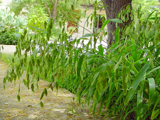Native Plants

Q. Who is Mr. Smarty Plants?
A: There are those who suspect Wildflower Center volunteers are the culpable and capable culprits. Yet, others think staff members play some, albeit small, role. You can torture us with your plant questions, but we will never reveal the Green Guru's secret identity.
Did you know you can access the Native Plant Information Network with your web-enabled smartphone?
Ask Mr. Smarty Plants is a free service provided by the staff and volunteers at the Lady Bird Johnson Wildflower Center.

rate this answer
Saturday - September 26, 2009
From: Austin, TX
Region: Southwest
Topic: Non-Natives
Title: Replacements for non-native purple fountain grass in Austin
Answered by: Barbara Medford
QUESTION:
Hi-- Just found out that the purple fountain grass I bought (fortunately on sale) is a) not native and b)not perennial. Dang it! If I can find the pots I'm taking it back. I have a part-shade well-drained corner of a yard on the Williamson/Travis county line, in Wells Branch. There is a happy native Anacacho orchid tree there already, which I plan to keep. Can you make some suggestions for drought/shade tolerant natives that won't be too high? Also need to be kid-friendly (not too many thorns or particularly poisonous). Thanks so much!ANSWER:
Sorry you got a non-native grass; unfortunately, most plant sales places are not familiar with the difference between native and non-native, and the plants are not marked that way. We're going to suggest some grasses native to Central Texas that do well in part shade, have no damaging or poisonous parts, and should be a good complement to your Bauhinia lunarioides (Texasplume), also known as Texas orchid tree. When you are shopping for native plants, go to our Native Plant Suppliers section, type your town and state in the"Enter Search Location" box, and you will get a list of native plant nurseries, seed companies and landscape consultants in your general area.
Our favorite grass for shade or part shade is Chasmanthium latifolium (Inland sea oats). It is perennial, growing to 2 to 4 ft tall. It has graceful, drooping foliage with the "oats" on the end, very decorative. Another grass that is graceful and attractive and grows well in shade is Nassella tenuissima (finestem needlegrass). The blades are not really needle-like, and we don't think they would hurt any curious children. Finally, a low shrub that does well in shade or part shade is Callicarpa americana (American beautyberry). It is deciduous, but has beautiful purple-pink berries which the wildlife love, but are not considered harmful if eaten. Follow each link to a page on that particular plant with information on ultimate size, culture and growing conditions.
Since you live in Austin, we hope you're planning to attend the Fall Plant Sale at the Wildflower Center. We just checked the projected plant list for this sale, and all four of the plants we have been discussing are on that list. This is not a guarantee that the plants will be available; the list has to be updated as information becomes available. It's a wonderful opportunity to catch up on plants native to Central Texas, talk to volunteers and staff people who love native plants, and visit tents from the Native Plant Society of Texas and Native American Seeds. The plant list has 323 plants on it, and there will be literally thousands of plants for sale in several container sizes.
Pictures from our Native Plant Image Gallery
More Non-Natives Questions
Foxglove (Digitalis purpurea)
July 02, 2014 - Foxglove (digitalis purpurea) is not a native U.S. plant. It was introduced to the U.S. from Europe and is now considered invasive in many parts of the western U.S. It invades our forested wild land...
view the full question and answer
Plant identification
June 11, 2010 - Dear Mr Smarty Pants.I hope you can help to save my sanity! I am a true believer in using native plantings, having a yard that is 99% native. I hope that fact provides me a little extra credit towar...
view the full question and answer
Non-native, invasive bermudagrass from Memphis TN
August 17, 2012 - I live in central Memphis and have well-drained clay soil. I have converted much of the front yard from turf grass to beds of native plants, which survive our hot humid without supplemental watering e...
view the full question and answer
Planting a non-native Solandra nitida in Cape Town, South Africa
August 26, 2009 - How long does it take a Cup of Gold (Solandra Nitida) to flower when planted from a cutting. The site is against a North facing wall. It gets afternoon sun. Plant looks healthy and is approximately ...
view the full question and answer
Information about Lotus berthelotte, non-native plant
October 19, 2007 - I have a plant marker for a plant called LOTUS Berthlotti. I am looking for how to take care of it, but when I type the name in any search engine I get no results! the best way for me to describe th...
view the full question and answer
| Support the Wildflower Center by Donating Online or Becoming a Member today. |

